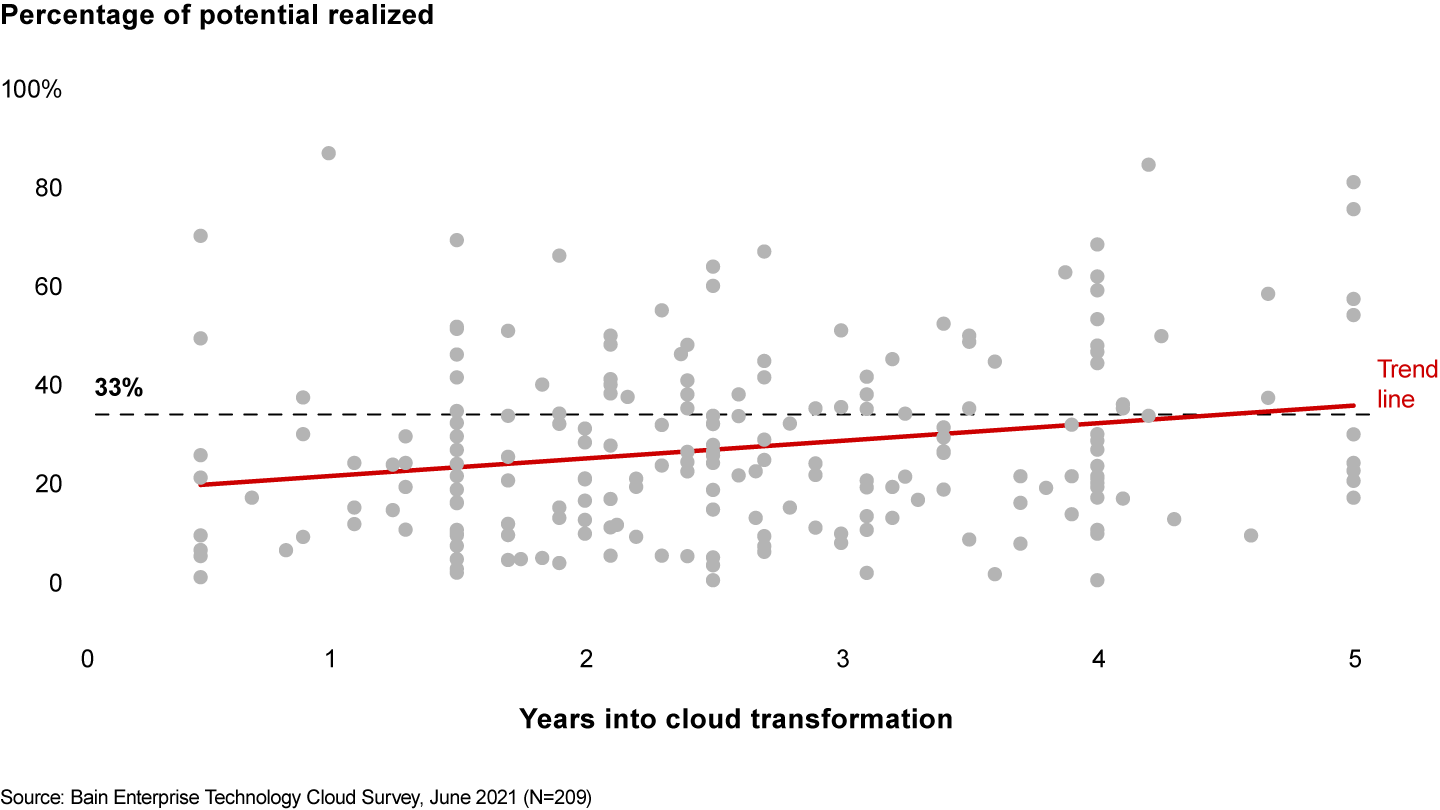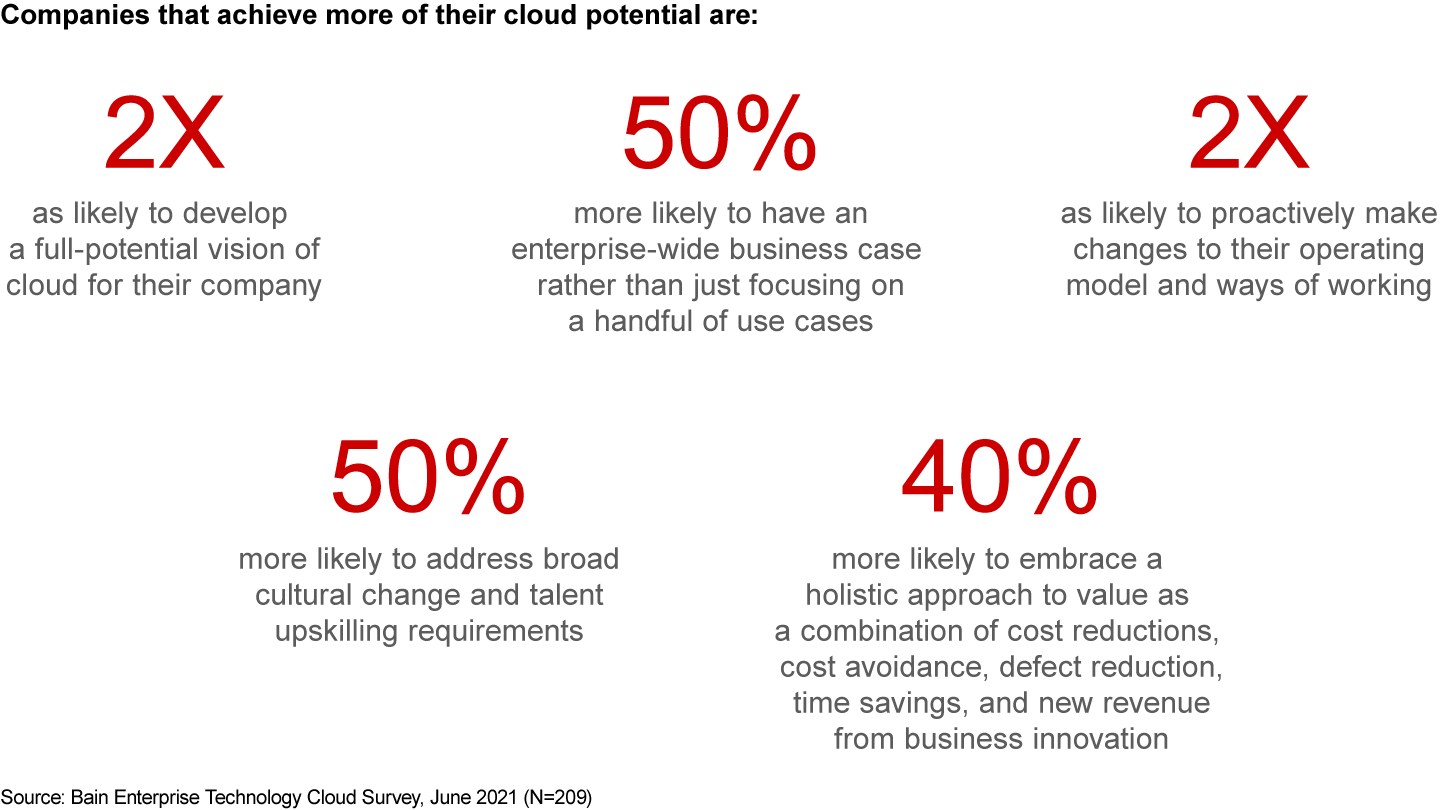Artikel

Auf einen Blick
- Few companies are getting as much out of their cloud strategy as they could if they set their ambitions higher.
- Most companies plateau at about one-third of their potential after five years of their cloud migrations.
- Shifting workloads to the cloud generates two kinds of value—the first being cost savings that result from higher productivity and lower technology unit costs.
- The other source of value could be much greater for most companies: the business innovations made possible by cloud infrastructure, which can create real market advantages.
Two decades into the migration to the cloud model, most companies have already shifted some of their workloads and committed to shifting more to the cloud. But surprisingly few have been able to capture as much value as they could if they pursued the cloud model more aggressively. Getting started is proving to be straightforward, but scaling cloud operations to their full potential within a large organization has been a difficult climb for many. Bain’s research finds several reasons for this.
- Most companies aim too low: Only about 1 in 20 companies set their ambitions high enough to target the full potential of the cloud model.
- Many companies hit a ceiling after about five years of effort and investments, having captured only about 35% of the potential (see Figure 1).
- These organizations run into scaling barriers after the initial euphoria of a few successful pilots.
Modernizing technology is an obvious hurdle to further success, with 46% of companies citing the challenge of working within legacy environments as a major barrier. Other significant barriers include difficulty finding the right engineering talent (54%) and overcoming entrenched organizational cultural barriers that keep teams working in their old ways (43%).

All these barriers can be overcome, but reaching full potential takes commitment and innovation. Leaders in cloud adoption—that is, those who are achieving greater scale benefits from the cloud model—are more likely to take specific actions, including setting high ambitions, changing entrenched work habits, and taking a more holistic approach to value creation (see Figure 2). In our experience, leaders are also more likely to take a customer-first approach to their business and operating models, a perspective that tends to benefit from the agility and flexibility of a cloud-based model.

For the many executives who find themselves in this large cohort of companies that have plateaued at 35%, the message is clear: Don’t give up. While it’s true that the easy gains have been won, greater potential lies ahead for companies that find ways to break through that ceiling. Forging greater ambition starts by understanding two questions:
- How does the cloud model help companies generate new value?
- How do companies that are stuck break through old barriers and build new momentum to scale?
Two main sources of value from the cloud
Migrating to the cloud generates two types of value: one on the bottom line and one on the top line. New bottom-line value results from cloud’s ability to make developers more productive while reducing the costs of delivering new technology. For the top line, cloud operating models make it easier to innovate, creating and launching new products and businesses in less time.
Higher productivity, lower unit costs: This is the value that most companies target initially, the core benefits of the cloud model that allow customers to scale up rapidly, pay per use, adapt with flexibility to new demands, and self-provision new infrastructure when needed. These benefits can shave about one-fifth off the unit costs of computing and storage, cut software development time in half or more, and reduce errors.
Two major barriers block companies from reaching these numbers. First, most are not setting their goals as high as they could, moving more of the business to the cloud model. Cloud initiatives should be pragmatic, but they can also push the limits of what’s possible within an industry. The greater the investment in cloud, the greater the return on investment.
Second, legacy companies struggle with old work habits and preferences that native cloud companies never have to face. Incumbents can move workloads to the cloud, but they also need to encourage employees to reinvent processes and consider cloud-based solutions first. Another element of this problem is that it’s hard to find enough engineers who are experienced working and developing in a cloud-based environment. Overcoming these barriers requires a blend of reskilling current employees while also attracting new talent.
Breakthrough business innovations: Beyond these cost benefits, cloud offers greater potential as an innovation platform. Launching new products months ahead of competitors or responding to massive disruptions (such as Covid-19 or supply chain shortages) can create real market advantages. When The Wall Street Journal saw an opportunity to deliver a compelling new feature during the 2020 US presidential campaign, it used machine learning services from Amazon Web Services (AWS) to quickly develop a searchable database of candidate quotes. The Journal wanted readers to be able to pose questions in natural language—such as “what did the president say about healthcare?”—and see results quickly based on text gleaned from Dow Jones’ Factiva database. The Journal’s team developed the service, Talk2020, in four months and was able to launch in September, two months before the election.
Bain’s research has found that a cloud-enabled insurgent can have operating cost advantages of 60% to 70% (as well as time-to-market advantages) over an incumbent weighed down by legacy ways of working and technology. Whether in banking, insurance, consumer products, pharmaceuticals, or utilities, incumbents increasingly risk being outhustled by smaller and faster, cloud-enabled insurgents. Moderna, for example, has steadily transformed from a discovery-stage biotech company into a commercial biopharma enterprise, developing a diverse portfolio of mRNA-based vaccines and therapeutics. Moderna’s investment in a cloud-based strategy with AWS helped the firm accelerate the test-and-learn cycles that supported the development of its highly effective Covid-19 vaccine as well as its ability to scale production globally.
Increasingly, market success requires integration with a broader set of ecosystem partners, many of whom are niche providers of new capabilities or data born in the cloud. The cloud model helps companies enter new markets quickly and gain access to new business capabilities by seamlessly partnering across a broad ecosystem and to new technologies such as artificial intelligence, machine learning, blockchain, and digital twinning.
But companies can only reap these benefits if the business side is dialed into cloud’s potential as an innovation platform. Cloud initiatives that are led only by the technology side of the business, with little buy-in from finance and business executives, tend to lose momentum. If, however, the business case includes upside from cloud advantages, such as faster time to market, the entire company is more likely to support an ambitious cloud program.
Ongoing education can help executives see the connections between cloud services, faster product design, and better customer experience. When the connections are clear, senior executives can become advocates for the cloud model. Boom Supersonic CEO Blake Scholl, for example, describes how that company’s ability to take advantage of high-performance computing on AWS allows for rapid design iteration at a savings of millions of dollars as it designs a supersonic passenger plane.
Breaking through the barriers
The transition from legacy ways of working to a cloud-enabled operating model at enterprise scale is hard work. But the paths of success taken by cloud leaders offer a playbook for effective transformation.
- Define cloud efforts with a customer-back orientation so that business executives can clearly understand how cloud will improve speed, cost, quality, and innovation, eventually leading to better outcomes with customers, such as more cross-selling and higher loyalty.
- Prepare a full-potential business case that considers all sources of enterprise value, including technology unit cost reduction, developer and engineering productivity, defect reduction, upside from new revenue sources, and value from more loyal customers.
- Design the cloud strategy to include new ways of working to accelerate the transformation of the operating model.
- Invest thoughtfully and in stages to put in place necessary technical foundations, including testing environments, product architectures, and migration plans.
- Educate executives and frontline staff with continuous learning so that the enterprise takes the most expansive view of cloud benefits and implications.
- Invest in engineering talent and culture, both of which are central to the cloud journey, and create a plan that includes developing new skills for the software engineering staff as well as hiring new, cloud-savvy talent.
Perhaps most important, underlying all these tactics should be a concerted effort to aim high, to determine to move as much work to the cloud as is feasible, and to keep the momentum rolling long after the initial enthusiasm wanes.

